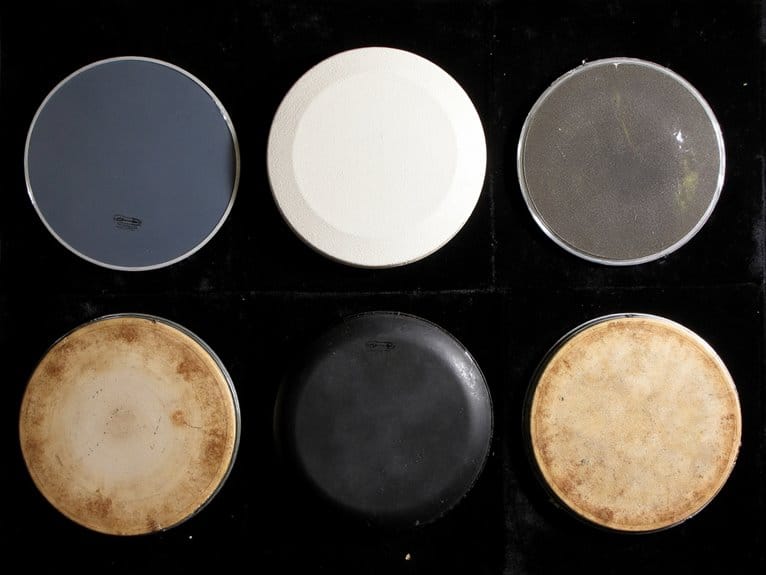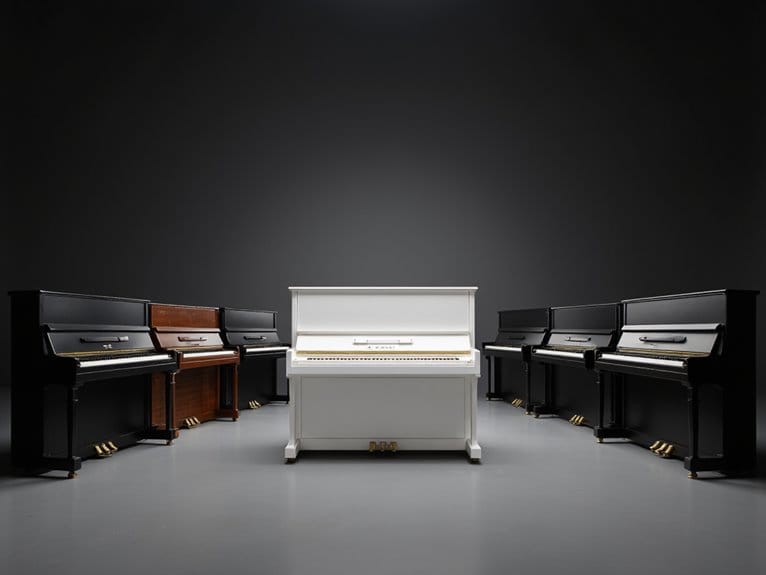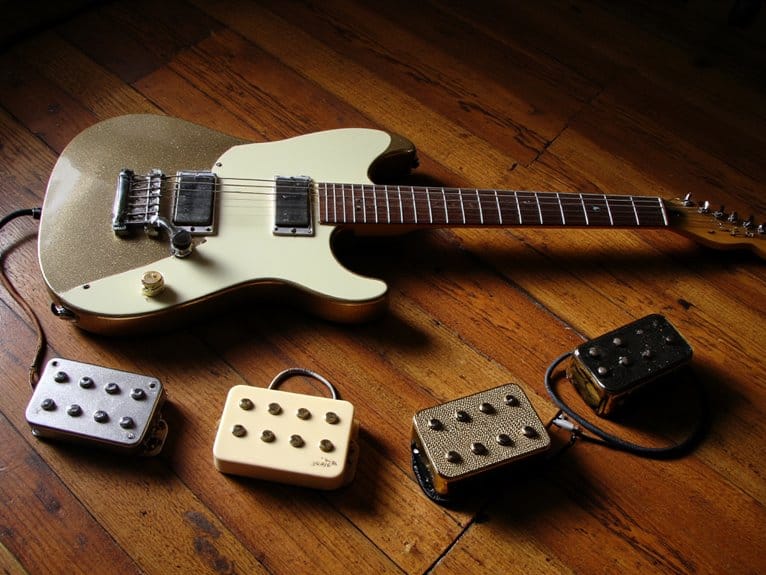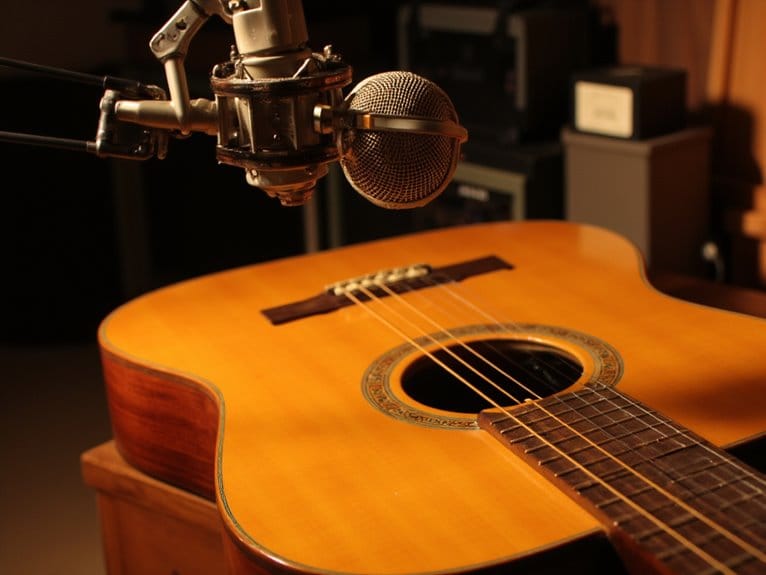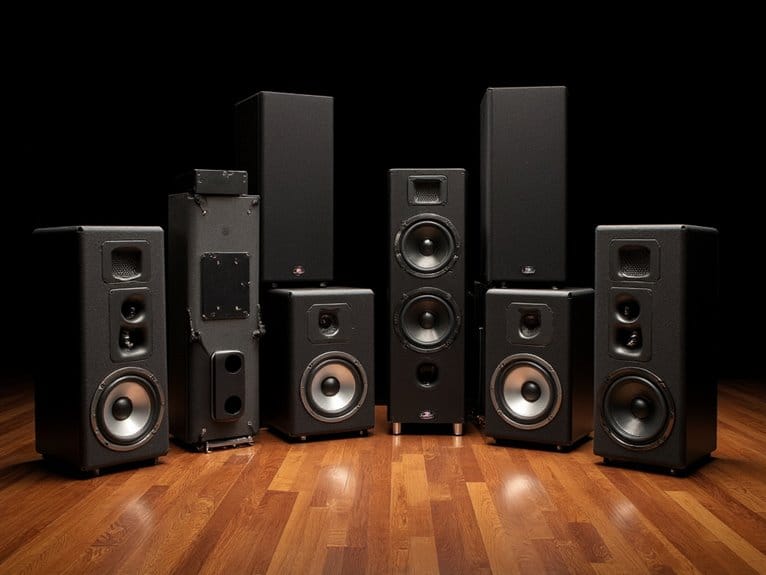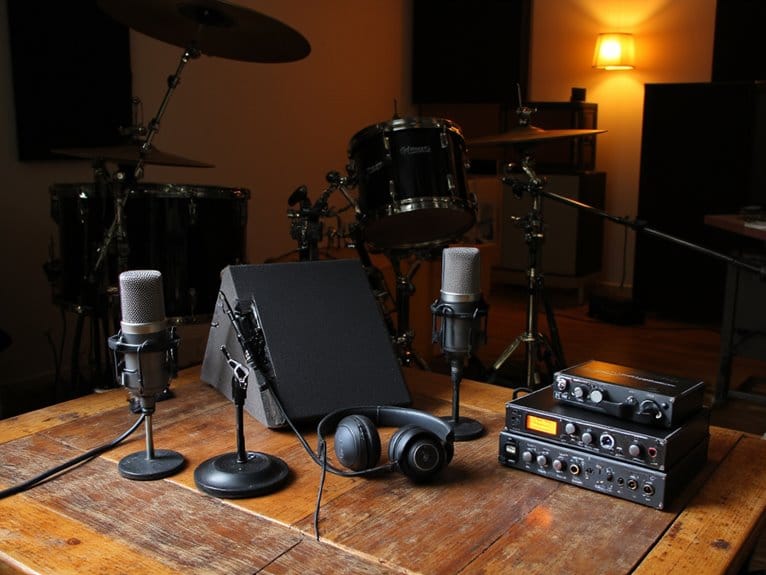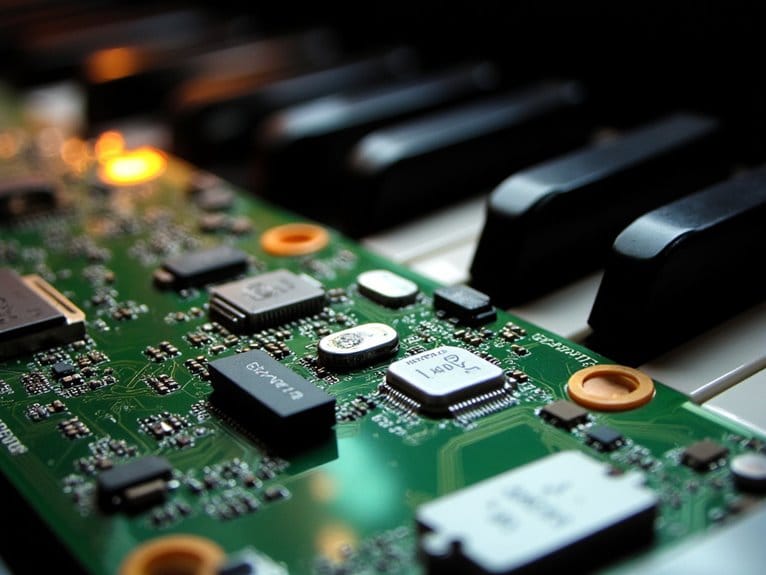Drum Head Selection for Different Genres
Your drum head selection dramatically shapes your sound, with single-ply heads (7-10 mil) delivering brightness and sensitivity perfect for jazz’s nuanced dynamics, while double-ply configurations provide the durability and controlled tone that rock and metal demand. I’ve found that Mylar offers consistent tonal qualities across genres, though Kevlar-based heads excel for heavy hitters who need extreme durability. Matching your head’s thickness to your playing style-alongside strategic tuning techniques-unlocks the professional sonic characteristics that’ll elevate your kit’s performance across any musical context.
We are supported by our audience. When you purchase through links on our site, we may earn an affiliate commission, at no extra cost for you. Learn more.
Notable Insights
- Single-ply heads (7-10 mil) provide sensitivity and brightness ideal for jazz and soft dynamics.
- Double-ply heads offer durability and controlled tone perfect for rock and heavy metal genres.
- Kevlar-based heads deliver extreme durability specifically designed for heavy metal applications.
- Integrated dampening rings eliminate excessive ring, making them essential for rock and metal styles.
- Lower batter tuning enhances bass response for metal while higher tuning increases funk clarity.
Understanding Drum Head Materials and Construction Types
When I first started playing drums seriously, I’ll admit I thought all drum heads were basically the same-just plastic circles that you hit with sticks.
Boy, was I wrong. Understanding materials and construction fundamentally changes your sound and performance experience.
Choosing the right drum head materials isn’t just gear obsession-it’s the difference between amateur sound and professional tone.
Mylar dominates the market for good reason, offering consistent tonal qualities in single or multiple plies.
Kevlar-based heads provide extreme drum head durability, handling tight tunings that would destroy standard heads, making them perfect for heavy metal‘s punishing demands.
Single-ply construction uses one thin sheet, typically 7-10 mil thick, delivering sensitivity and brightness with natural overtone ring.
Double-ply heads stack two layers for enhanced durability and controlled sound. Two-ply constructions also provide focused tone with reduced sustain, making them particularly effective for rock music applications.
The ply construction advantages become clear when you realize thickness impacts stiffness exponentially-doubling thickness increases stiffness eight times, dramatically affecting both durability and tonal response.
Both batter and resonant heads work together to shape your drum’s overall sound, with their combined characteristics determining the final tonal outcome. Before Mylar’s introduction in the 1950s revolutionized drumheads, musicians struggled with animal hide heads that changed dramatically with weather conditions.
Matching Head Thickness and Ply Configuration to Musical Styles
Now that you understand how materials and construction affect your drums’ fundamental characteristics, the real challenge becomes matching these technical specifications to your actual playing style and musical demands.
I’ve found that ply variation effects greatly impact your sound projection dynamics, with single-ply heads delivering brighter sensitivity for jazz applications, while double-ply configurations provide the durability and focused attack that rock and metal require.
Consider these playing style compatibility factors:
- Soft dynamics – Choose thin single-ply heads for nuanced ghost notes and articulation
- Heavy hitters – Select thick double-ply heads for controlled tone under aggressive impact
- Mixed genres – Opt for medium thickness configurations balancing versatility with durability
Regarding head maintenance tips, thicker double-ply heads withstand harder playing longer, reducing replacement frequency. Your striking angle positioning directly affects how long your drumheads will last, so maintaining flatter contact with the head surface helps maximize durability.
While thin heads require gentler treatment but reward you with superior responsiveness. Remember that batter heads are specifically designed to be struck and handle the direct impact from your sticks or hands.
Specialty Features for Genre-Specific Sound Control
Beyond the fundamental thickness and ply considerations I’ve covered, modern drum head manufacturers have developed an impressive array of specialty features that let you dial in genre-specific tonal characteristics with surgical precision.
Modern drum head innovations allow drummers to achieve genre-specific tonal precision that was previously impossible without extensive external modifications.
You’ll find integrated dampening rings that eliminate excessive ring for rock and metal applications, while specialized coatings like textured surfaces or central dots enhance durability and focus attack in heavy-hitting genres.
For overtone control, manufacturers incorporate subsonic dampening elements in bass heads that deepen fundamental tones without external muffling, and snap-on systems that allow real-time adjustments between tight funk grooves and booming rock passages.
These innovations mean you can achieve studio-quality sound control whether you’re tracking delicate jazz brushwork or thunderous double-bass metal, all without constantly swapping heads or adding external dampening accessories. Jazz drummers consistently favor thinner drumheads that respond better to brushwork and provide the brighter attack characteristic of the genre.
Tuning Techniques and Head Pairing Strategies Across Genres
Once you’ve selected the right heads for your genre, the relationship between your batter and resonant head tuning becomes the secret weapon that separates amateur-sounding kits from professional setups that cut through any mix.
Your head pairing strategy directly impacts sustain, pitch character, and tonal articulation in ways that can make or break your sound.
Effective tuning techniques follow three fundamental approaches:
- Same pitch tuning maximizes sustain and resonance, perfect for jazz’s full-bodied requirements
- Higher batter tuning increases attack and treble presence for funk’s punchy clarity
- Lower batter tuning enhances bass response while reducing stick attack for metal’s controlled thump
I’ve found that experimenting within these relationships, rather than committing to one universal approach, allows you to match specific songs and performance contexts with surgical precision. Professional results require maintaining even tension across all tension rods to prevent unwanted overtones that muddy your carefully crafted sound. Since drum heads account for the majority of your drum’s sonic character, understanding these tuning relationships becomes essential for achieving genre-appropriate sounds.
Remember that harmonic content influences how your drums sit in the mix, with careful attention to head selection enhancing the overall perception of your kit’s sound quality across different musical styles. Choosing the right cymbals to complement your drum kit also requires consideration of their harmonic characteristics, which can either blend seamlessly with your toms or create a jarring effect. Additionally, experimenting with sizes and tuning for tom setups can further refine your sound, allowing you to find the perfect balance that suits your playing style and genre. This holistic approach will ensure that every element of your kit works together harmoniously, resulting in a more polished and cohesive mix.
On a final note
You’ll discover that choosing the right drum heads transforms your sound more dramatically than you might expect, though I’ve learned through countless studio sessions that even expensive heads won’t fix poor tuning technique. Remember, matching your head selection to your genre’s requirements, whether you’re pursuing jazz’s warm resonance or metal’s aggressive attack, creates the foundation for achieving professional results that’ll make your kit sound exactly how you’ve always envisioned it should.

